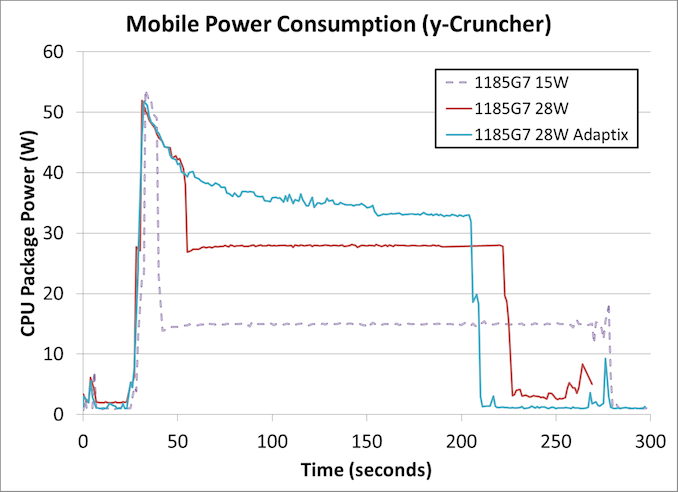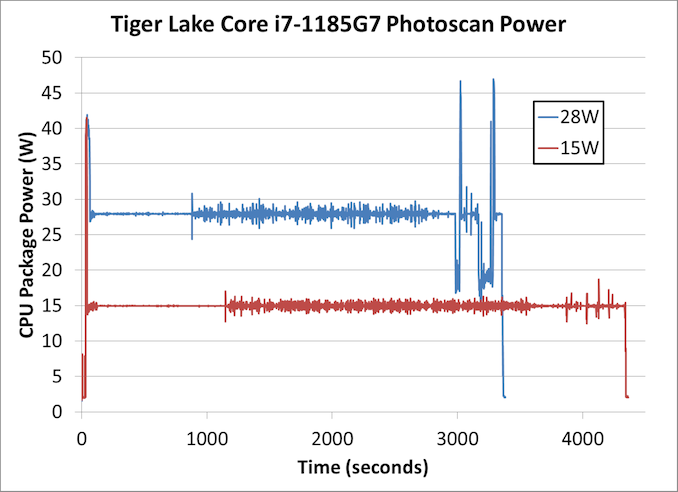Intel’s Tiger Lake 11th Gen Core i7-1185G7 Review and Deep Dive: Baskin’ for the Exotic
by Dr. Ian Cutress & Andrei Frumusanu on September 17, 2020 9:35 AM EST- Posted in
- CPUs
- Intel
- 10nm
- Tiger Lake
- Xe-LP
- Willow Cove
- SuperFin
- 11th Gen
- i7-1185G7
- Tiger King
Comparing Power Consumption: TGL to TGL
On the first page of this review, I covered that our Tiger Lake Reference Design offered three different power modes so that Intel’s customers could get an idea of performance they could expect to see if they built for the different sustained TDP options. The three modes offered to us were:
- 15 W TDP (Base 1.8 GHz), no Adaptix
- 28 W TDP (Base 3.0 GHz), no Adaptix
- 28 W TDP (Base 3.0 GHz), Adaptix Enabled
Intel’s Adaptix is a suite of technologies that includes Dynamic Tuning 2.0, which implements DVFS feedback loops on top of supposedly AI-trained algorithms to help the system deliver power to the parts of the processor that need it most, such as CPU, GPU, interconnect, or accelerators. In reality, what we mostly see is that it reduces frequency in line with memory access stalls, keeping utilization high but reducing power, prolonging turbo modes.
Compute Workload
When we put these three modes onto a workload with a mix of heavy AVX-512 compute and memory accesses, the following is observed.
Note that due to time constraints this is the only test we ran with Adaptix enabled.
This is a fixed workload to calculate 2.5 billion digits of Pi, which takes around 170-250 seconds, and uses both AVX-512 and 11.2 GB of DRAM to execute. We can already draw conclusions.
In all three power modes, the turbo mode power limit (PL2) is approximately the same at around 52 watts. As the system continues with turbo mode, the power consumed is decreased until the power budget is used up, and the 28 W mode has just over double the power budget of the 15 W mode.
Adaptix clearly works best like this, and although it initially follows the same downward trend as the regular 28 W mode, it levels out without hitting much of a ‘base’ frequency at all. Around about the 150 second mark (120 seconds into the test), there is a big enough drop followed by a flat-line which would probably indicate a thermally-derived sustained power mode, which occurs at 33 watts.
The overall time to complete this test was:
- Core i7-1185G7 at 15 W: 243 seconds
- Core i7-1185G7 at 28 W: 191 seconds
- Core i7-1185G7 at 28 W Adaptix: 174 seconds
In this case moving from 15 W to 28 W gives a 27% speed-up, while Adaptix is a total 40% speed-up.
However, this extra speed does come at the cost of total power consumed. With most processors, the peak efficiency point is when the system is at idle, and while these processors do have a good range of high efficiency, when the peak frequencies are requested then we are in a worst case scenario. Because this benchmark measures power over time, we can integrate to get total benchmark power consumed:
- Core i7-1185G7 at 15 W: 4082 joules
- Core i7-1185G7 at 28 W: 6158 joules
- Core i7-1185G7 at 28 W Adaptix: 6718 joules
This means that for the extra 27% performance, an extra 51% power is used. For Adaptix, that 40% extra performance means 65% more power. This is the trade off with the faster processors, and this is why battery management in mobile systems is so important - if a task is lower priority and can be run in the background, then that is the best way to do it to conserve battery power. This means things like email retrieval, or server synchronization, or thumbnail generation. However, because users demand the start menu to pop up IMMEDIATELY, then user-experience events are always put to the max and then the system goes quickly to idle.
Professional ISV Workload
In our second test, we put our power monitoring tools on Agisoft’s Photoscan. This test is somewhat of a compute test, split into four algorithms, however some sections are more scalable than others. Normally in this test we would see some sections rely on single threaded performance, while other sections use AVX2.
This is a longer test, and so the immediate turbo is less of a leading factor across the whole benchmark. For the first section the system seems content to sit at the respective TDPs, but the second section shows a more variable up and down as power budget is momentarily gained and then used up immediately.
Doing the same maths as before,
- At 15 W, the benchmark took 4311 seconds and consumed 64854 joules
- At 28 W, the benchmark took 3330 seconds and consumed 92508 joules
For a benchmark that takes about an hour, a +30% performance uplift is quite considerable, however it comes at the expense of +43% power. This is a better ratio than the first compute workload, but still showcases that 28 W is further away from Tiger Lake’s ideal efficiency point.
Note that the power-over-time graph we get for Agisoft on a mobile processor looks very different to that of a desktop processor, as a mobile processor core can go above the TDP budget with fewer threads.
This leads to the dichotomy of mobile use cases with respect to the marketing that goes on for these products - as part of the Tiger Lake launch, Intel was promoting its use for streaming, professional workflows such as Adobe, video editing and content creation, and AI acceleration. All of these are high-performance workloads, compared to web browsing or basic office work. Partly because Tiger Lake is built on the latest process technology, as well as offering Intel’s best performing CPU and GPU cores, the product is going to be pitched in the premium device market for the professionals and prosumers that can take advantage.












253 Comments
View All Comments
MDD1963 - Saturday, September 19, 2020 - link
Although equaling/exceeding 7700K-level of performance within a 50W envelope in a laptop is impressive, the 4c/8t design is going to cause at least one or two frowns/raised eyebrows...ballsystemlord - Saturday, September 19, 2020 - link
@Ian why do these companies always seem to have the worst timing on sending you stuff? Do you tell them when you'll be on vacation?Thanks for the review!
Ian Cutress - Sunday, September 20, 2020 - link
It's happened a lot these past couple of years. The more segments of the tech industry you cover, the less downtime you have - my wife obviously has to book holiday months in advance, but companies very rarely tell you when launches are, or they offer surprise review samples a few days before you are set to leave. We do our best to predict when the downtime is - last year we had hands on with the Ice Lake Development system before the announcement of the hardware, and so with TGL CPUs being announced first on Sep 2nd, we weren't sure when the first units were coming in. We mistimed it. Of course with only two/three of us on staff, each with our own segments, it's hard to get substitutes in. It can be done, Gavin helped a lot with TR3 for example. But it depends on the segment.And thanks :)
qwertymac93 - Sunday, September 20, 2020 - link
Finally a decent product from Intel. It's been a while. Those AVX512 numbers were impressive. Intel is also now able to compete toe to toe with AMD integrated graphics, trading blows. I feel that won't last, though. AMD is likely to at least double the GPU horsepower next gen with the move from a tweaked GCN5 to RDNA2 and I don't know if Intel will be able to keep up. Next year will be exciting in any case.Spunjji - Sunday, September 20, 2020 - link
It'll be a while before we get RDNA2 at the high end - looks like late 2021 or early 2022. Before that, it's only slated to arrive with Van Gogh at 7-15Wefferz - Monday, September 21, 2020 - link
It is very interesting to see that the intel complier make the SPECint2017 scores 52% higher than other compliers without 462.libquantum.helpMeImDying - Thursday, September 24, 2020 - link
Hello, before ranting I want to know if the scores of spec2006 and spec2017 were adjusted/changed based on processors frequency(Read something like that in the article)? Because you can't do that. Frequencies should be out of the topic here unless comparing same generation CPU's and even then there are some nuances. What matters is the performance per watt comparing low power notebooks. It can be done mathematically, if the TDP can't be capped at the same level all the time, like you did in the first few pages. I'm interested in scores at 15W and 25W. So you should have and should in the future monitor and publish power consumed numbers near the scores.And if you are adjusting scores based on CPU frequencies, then they are void and incorrect.
helpMeImDying - Thursday, September 24, 2020 - link
Btw, same with iGPUs.beggerking@yahoo.com - Friday, September 25, 2020 - link
none of the tests seem valid... some are intel based others are AMD based... I don't see a single test where Ryzen beats 10th gen but loses to 11th gen on standard 15 watt profile...the speed difference between 10th and 11th gen intel is approx 10-15%.. its good, but probably not worth the price premium since Ryzen is already cheaper than 10th gen, i don't see how 11th gen would go cheaper than Ryzen...
legokangpalla - Monday, September 28, 2020 - link
I always thought AVX-512 was a direct standoff against heterogenous computing.I mean isn't it a better idea to develop better integrations for GPGPU like SYCL, higher versions of OpenCL etc? Programming with vector instructions IMO is lot more painful compared to writing GPU kernels and tasks like SIMD should be offloaded to GPU instead being handled by CPU instruction(CPU instruction with poor portability).